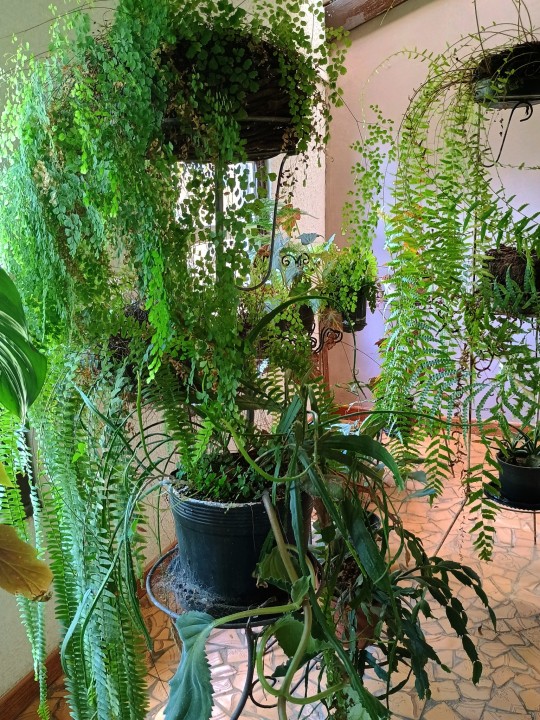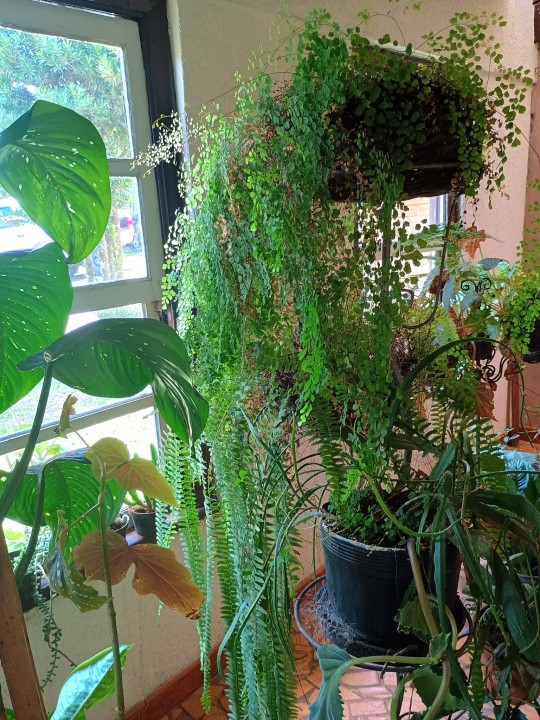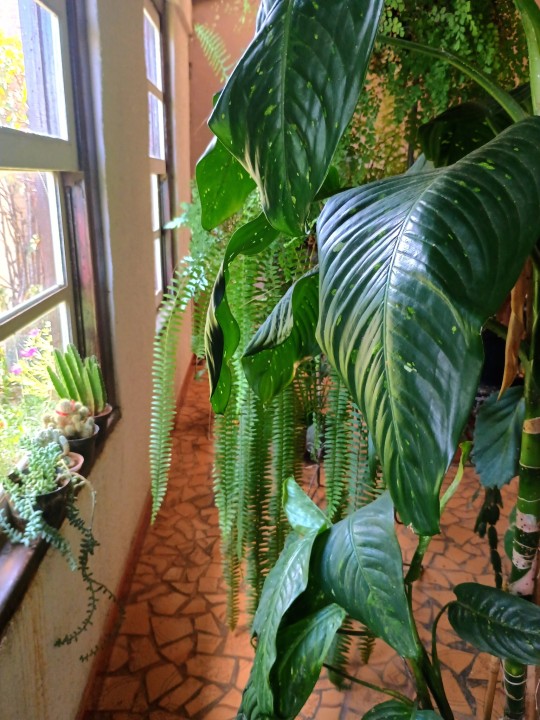#Pteridaceae
Explore tagged Tumblr posts
Text



💚
#goodmornig#nature#green house#photo#sunnyday#adiantum#avenca#pteridaceae#maidenhair#home#summer24#fern plant
10 notes
·
View notes
Text
#2242 - Pellaea rotundifolia - Button Fern


From the Greek word πελλος (pellos), meaning "dark," and refers to the brown stems, and the Latin rotundifolia means "round-leaved". The genus are usually refered to as cliffbrakes, growing in rocky habitats, including moist rocky canyons, slopes, and bluffs.
New Zealand, but now also growing in Australia. Quite a popular garden plant, prefering drier soil than most ferns. Compact, with fronds up to 460mm long,
Huka Falls, Taupo Volcanic Zone, New Zealand
4 notes
·
View notes
Text
Northern Maidenhair Fern
Adiantum Pedatum (A-D-in-tuh-mm Ped-ah-tuh-mm)
The symbolic meanings are Bonds of Love, Confidence, and Traditional dancing.
Possible powers include Aphrodisiacs, Attracting Love, Beauty, Dancing, Feminine Energy, Invisibility, Love, Venus, and the Water Element.
(Whenever a plant includes Venus(Roman Goddess of Love), you can assume that it includes the Water Element. She was formed in the sea.)
Folklore and Facts
The Druids believed Northern Maidenhair Fern could bestow invisibility.
The Native American tribes used it as a symbol of their traditional dancing. Northwest Coastal Native American Tribes may include it as part of their traditional dance regalia.
There is an unproven belief that by holding a nosegay of self gathered sprigs of Rue, Broom, Maidenhair Fern, Agrimony, and Ground Ivy, one can gain intuition of who is and who is not a practicing witch.
Northern maidenhair fern (Adiantum pedatum L.) is a deciduous, perennial fern native to Wisconsin.
It’s native to regions of North America, temperate East Asia and Himalayas within plant hardiness zones 3 – 8.
Northern maidenhair fern is a member of the Adiantaceae, a sub-family of the Pteridaceae family.


#fun facts#flower language#flowers#herbs#plants#symbols#plant blog#plantbased#Northern Maidenhair Ferns#Adiantum Pedatum
1 note
·
View note
Text





Adiantum raddianum
Nome científico: Adiantum raddianum Nome comum: Avenca Família: Pteridaceae Origem: As avencas são originárias de regiões tropicais e subtropicais ao redor do mundo.
Características:
As frondes são folhas verdes delicadas e triangulares.
As frondes são semi-eretas no início e caem graciosamente à medida que envelhecem.
Tamanho das frondes: podem atingir até 30 cm de comprimento por 15 cm de largura.
Possui folhas brilhantes e escuras que se assemelham ao cabelo humano.
As raízes são delgadas e curtas.
O caule é ereto, cilíndrico e pode ter coloração bege a castanho.
A planta forma cáudice (estrutura engrossada do caule na base).
A Adiantum raddianum ganhou o Prêmio de Mérito da Royal Horticultural Society. O epíteto específico "raddianum" é uma homenagem ao botânico italiano Giuseppe Raddi (1770-1829).
wikimedia-adiantum-radianum
0 notes
Text




Found a very cool little limestone seep in a park that is otherwise pretty bereft of ferns and mosses.
97 notes
·
View notes
Text

Pteris vittata, aka Chinese brake, ladder brake, or Chinese ladder brake, is the first plant identified to be able to hyperaccumulate arsenic and reduce its quantities in soil. Scientists have been proposing for a while that this fern could be useful in phytoremediation (extracting and removing/reducing the amount of elemental pollutants in soil).
#pteris vittata#chinese brake#ladder brake#chinese ladder brake#arsenic#phytoremediation#pollutants#pollution cleaning plants#fern#pteridaceae
3 notes
·
View notes
Text

6/1/22
2 notes
·
View notes
Photo

Adiantum raddianum (Pteridaceae)
Delta maidenhair fern
Bergianska Trädgården | Mar. 3, 2020
guess I’m going through a fern phase *starts sporulating*
#botany#plants#fern#ferns#Adiantum#Adiantum raddianum#Pteridaceae#Polypodiales#Vittarioideae#maidenhair fern#delta maidenhair fern#botanical gardens#botanical garden#Bergianska Trädgården#Bergius Botanic Garden#Edvard Andersons växthus#Edvard Anderson Conservatory#Stockholm#Sweden#banished to Fennoscandia#photo thursday
97 notes
·
View notes
Video
H20130518-8225—Pentagramma visccosa—RPBG-1 by John Rusk Via Flickr: Pentagramma viscosa—sticky goldback fern. Moved in 2016 form Pentagramma triangularis ssp. viscosa—sticky goldback fern to its current taxon of P. viscosa. Ranges from the Channel Islands and Los Angeles County southward into Baja California usually in proximity to the Pacific Ocean , although there are a few inland populations according to CalFlora range map for the species. The common name comes from the sticky fluid it exudes, unique within the genus Pentagramma. Photographed at Regional Park Botanic Garden located in Tilden Regional Park near Berkeley, CA
#taxonomy:kingdom=Plantae#Plantae#taxonomy:superphylum=Tracheophyta#Tracheophyta#taxonomy:phylum=Pteridophyta#Pteridophyta#taxonomy:class=Filicopsida#Filicopsida#taxonomy:order=Polypodiales#Polypodiales#taxonomy:family=Pteridaceae#Pteridaceae#taxonomy:genus=Pentagramma#Pentagramma#taxonomy:species=triangularis#taxonomy:phylum=Tracheophyta#taxonomy:class=Polypodiopsida#Polypodiopsida#taxonomy:subclass=Polypodiidae#Polypodiidae#taxonomy:subfamily=Cheilanthoideae#Cheilanthoideae#taxonomy:binomial=Pentagramma triangularis#taxonomy:trinomial=Pentagramma triangularis viscosa#Pentagramma triangularis viscosa
4 notes
·
View notes
Photo

This nifty little plant is actually a fern called Doryopteris pilosa. It is often incorrectly labelled as D. cordata. What you see are the sterile fronds. The fertile fronds look much more fern-like and lift well above the rest of the plant, no doubt in order to use the breeze to disperse its spores. This species hails from South Africa. #ferns #fernsofinstagram #fernstagram #plant #plantsofinstagram #plantoftheday #botany #botanical #botanizing #garfieldconservatory #chicago #botanicalgarden #conservatory #nature #SouthAfrica #fronds #pteridophyte #pteridaceae #Doryopteris
#plantsofinstagram#nature#plant#pteridaceae#botany#fernstagram#southafrica#botanizing#chicago#fronds#botanicalgarden#fernsofinstagram#doryopteris#ferns#pteridophyte#plantoftheday#conservatory#garfieldconservatory#botanical
87 notes
·
View notes
Photo

Aspidotis carlotta-halliae by Ken-ichi on Flickr.
#Aspidotis carlotta-halliae#Plantae#Tracheophyta#Pteridopsida#Polypodiales#Pteridaceae#Aspidotis#Carlotta Hall's lace fern
0 notes
Photo


Star Cloak Fern or Stadley's Cloak Fern Notholaena stadleyi
Concan, Texas, United States, 2015 Garner State Park
#star cloak fern#standley's cloak fern#notholaena standleyi#cloak fern#notholaena#polypodiales#pteridaceae#pteridophyte#leptosporangiate fern#polypodiopsida#pteridopsida#fern#pteridophyta#plant#Concan#Texas#United States#Garner State Park
49 notes
·
View notes
Text
#2240 - Adiantum cunninghamii - Cunningham's Maidenhair

From the Greek a- ‘without, lacking’ and diantos ‘moistened’ because the fronds of this fern are supposed to remain dry after submersion in water, and Allan Cunningham (1791–1839) an English botanist and explorer, primarily known for his travels to New South Wales and New Zealand to collect plants. Author of Florae Insularum Novae Zelandiae Precursor, 1837–40 (Introduction to the flora of New Zealand).
An Aotearoan endemic, common in coastal and lowland forest areas grows on banks and among boulders especially on limestone, marble, basalt or andesite rocks. The rhizome creeps widely once established. Dark green on top of frond and a blue-green underneath.
Huka Falls, Taupo Volcanic Zone, New Zealand.
0 notes
Photo

Pteridaceae: Adiantum sp.
1 note
·
View note
Text
Growing and Caring Tips for Maidenhair Fern Indoors
Growing and Caring Tips for Maidenhair Fern Indoors
Maidenhair fern belongs to the Pteridaceae family. It has over 200 other species. They are well-known for their lacy, delicate leaves, which are called fronds. It grows well in rich woodlands and limestone soil, dampened by the spray of near water. Maidenhair fern is native to South Europe, Amazon, Brazil, and Pacific Northwest, Peru. It is also native to the southern states, from Florida to…

View On WordPress
0 notes
Video
2014-12-21-15.06.17 ZS PMax Cheilanthes covillei by John Rusk Via Flickr: Myriopteris covillei (Syn Cheilanthes covellei)—Colville's lip fern. "This fern has green leaves which may be up to 4-pinnate, that is, made up of leaflets that subdivide 3 times, such that the leaflets are layered with overlapping rounded segments. The leaves have a bumpy, cobbled look. The undersides of the leaves have scales which are lengthened outgrowths of the epidermis. Tucked under the scales are the sporangia, which make the spores" (Wikipedia, Cheilanthes covillei.) The frond is from a plant at Regional Parks Botanic Garden located in Tilden Regional Park near Berkeley, CA
#Olympus Pen E-PL1 Body#Canon FD 100 mm Macro Lens#ISO 100#F/stop f4#Zerene Stacker#Stack of 12 images#taxonomy:kingdom=Plantae#Plantae#taxonomy:clade=Tracheophyta#Tracheophyta#taxonomy:phylum=Pteridophyta#Pteridophyta#taxonomy:class=Filicopsida#Filicopsida#taxonomy:order=Polypodiales#Polypodiales#taxonomy:family=Pteridaceae#Pteridaceae#taxonomy:genus=Myriopteris#Myriopteris#taxonomy:species=covillei#taxonomy:binomial=Myriopteris covillei#Coville's lip fern#Myriopteris covillei#taxonomy:common=Coville's lip fern
0 notes
